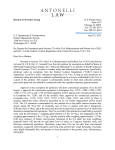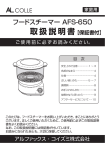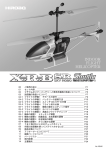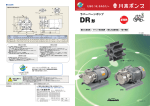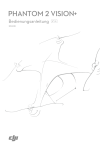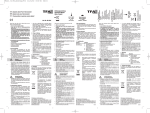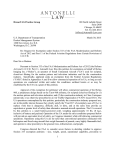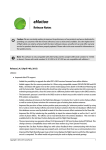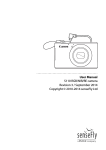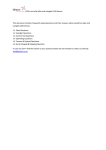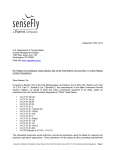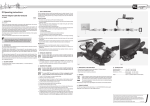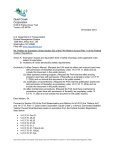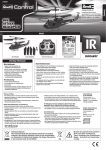Download Volo Pervidi LLC - Drone Laws Blog by Antonelli Law
Transcript
Drone/UAS Practice Group 100 North LaSalle Street Suite 2400 Chicago, IL 60602 Tel. 312.201.8310 [email protected] U.S. Department of Transportation Docket Management System 1200 New Jersey Ave S.E. Washington, D.C. 20590 March 30, 2015 Re: Request for Exemption under Section 333 of the FAA Modernization and Reform Act of 2012 and Part 11 of the Federal Aviation Regulations from Certain Provisions of 14 C.F.R. Dear Sir or Madam: Pursuant to Section 333 of the FAA Modernization and Reform Act of 2012 (the Reform Act) and 14 C.F.R. Part 11, Antonelli Law files this petition for exemption on behalf of Volo Pervidi, LLC (“Volo Pervidi”), an operator of Small Unmanned Aircraft (“UA”) Systems (“UAS”) used to conduct geospatial analysis. Specifically, applicant seeks an exemption from the Federal Aviation Regulations (“FARs”) listed in Appendices A and B to allow commercial operation of its UAs, so long as such operations are conducted within and under the conditions outlined herein or as may be established by the FAA in a grant of this petition. Approval of the exemption for petitioner will allow commercial operation of the senseFly eBee and the DJI Phantom 2 Vision+ for geospatial analysis in Class G airspace nationwide, or as otherwise prescribed in an Air Traffic Organization (“ATO”) issued COA. The UA operations contemplated by this petition are in the public interest because they clearly satisfy the "Four D's" of exemplary uses of unmanned aircraft: to replace work that is dangerous, difficult, dull, or dirty, and at the same time provide an equivalent or greater level of safety than alternative manned aircraft operations. The UA covered by this petition are small battery-powered craft, with the eBee weighing approximately 1.52 lbs. (0.69 kg.), inclusive of battery and payload, and the Phantom weighing approximately 2.7 lbs. (1.2kg), inclusive of battery and payload. Operation of the UAs under the strict conditions proposed below will provide an equivalent level of safety, as Congress intended, while still allowing commercial operations. Operations using these UAs are far safer than conventional operations conducted with helicopters and fixed-wing aircraft that weigh thousands of pounds, carry highly flammable fuel, and operate in close proximity to the ground, trees, infrastructure, and people. Congress directed the FAA to consider seven factors in deciding whether to approve Section 333 exemption petitions - size, weight, speed, operational capability, proximity to airports, proximity to populated areas, and operation within visual line of sight. In this case, each factor supports the exemption request. In particular, the UAs are small, and will operate at slow 1 Table of Contents I. Publishable Summary ........................................................................................................................... 5 II. Petitioner’s Contact Information........................................................................................................... 5 III. Proposed Operations ............................................................................................................................. 6 A. The UA........................................................................................................................................ 6 B. The Crew ........................................................................................................................ 7 C. Flight Conditions ............................................................................................................ 7 D. Flight Operations ............................................................................................................ 8 IV. Aircraft and Equivalent Level of Safety .................................................................................. 9 V. Proposed Conditions of the Exemption ................................................................................... 9 VI. Privacy ................................................................................................................................... 12 VII. Public Interest and Safety ...................................................................................................... 13 VIII. A. B. Regulations from Which Exemption is Requested ...................................................... 15 Appendix A: FARs as to which Volo Pervidi wishes the same determination to be made as has been made previously............................................................................... 15 Appendix B: Volo Pervidi’s argument for exemption from 14 C.F.R. §61.113: Private pilot privileges and limitations: Pilot in command. ..................................................... 18 1. The FAA and foreign regulators recognize that obtaining a manned aircraft pilot license is unnecessary for safe operation of a UA ................................................ 18 2. The FAA has and has already exercised the authority to exempt applicants from the airman certificate requirement ........................................................................ 20 3 Exhibit List senseFly eBee Documents Exhibit 1: Volo Pervidi LLC eBee Safety Plan ....................... Submitted confidentally to the FAA Exhibit 2: senseFly eBee Training Documentation ................ Submitted confidentially to the FAA Exhibit 3: eBee User Manual .................................................. Submitetd confidentially to the FAA Exhibit 4: eBee Technical Specs................................................................................................... 23 Exhibit 5: senseFly eBee ............................................................................................................... 25 Exhibit 6: senseFly eMotion ......................................................................................................... 30 Exhibit 7: senseFly Postflight Terra 3D........................................................................................ 34 DJI Phantom 2 Vision+ Documents Exhibit 8: Volo Pervidi LLC DJI Phantom 2 Vision+ Safety Plan .................................................. ................................................................................................. Submitted confidentially to the FAA Exhibit 9: DJI Phantom 2 Vision+ Pilot Training ............................................................................ .................................................................................Submitted separately due to upload constraints Exhibit 10: DJI Phantom 2 Vision+ User Manual ............................................................................ .................................................................................Submitted separately due to upload constraints Exhibit 11: DJI Phantom 2 Vision+ Quick Start Guide .................................................................................Submitted separately due to upload constraints Exhibit 11: DJI Phantom 2 Vision+ .............................................................................................. 38 Exhibit 12: DJI Phantom 2 Vision+ Features ............................................................................... 41 Exhibit 13: DJI Phantom 2 Vision+ Specifications ...................................................................... 50 Exhibit 14: DJI Naza-M v2 Flight Control User Manual ................................................................. .................................................................................Submitted separately due to upload constraints Exhibit 15: DJI Smart Flight Battery ............................................................................................ 53 Exhibits 1-3 and 8 have been submitted to the FAA confidentially and are not available to the public. 4 I. Publishable Summary Pursuant to 14 C.F.R. § 11, the following summary is provided for publication in the Federal Register, should it be determined that publication is needed: Applicant seeks an exemption from the following rules: 14 C.F.R 21(h); 14 C.F.R. 43.7; 14 C.F.R. 43.11; 14 C.F.R. 45.11; 14 C.F.R. 45.27; 14 C.F.R. 45.29; 14 C.F.R. 91.7(a); 14 C.F.R. 91.9(b)(2); 14 C.F.R. 91.9(c); 14 C.F.R. 91.103(b)(2); 14 C.F.R. 91.105; 14 C.F.R. 91.109; 14 C.F.R. 91.113(b); 14 C.F.R. 91.119(c); 14 C.F.R. 91.121; 14 C.F.R. 91.151(a); 14 C.F.R. 91.203(a) and (b); 14 C.F.R. 215; 14 C.F.R. 91.403; 14 C.F.R. 91.405(a); 14 C.F.R. 91.407(a)(1); 14 C.F.R. 409(a)(1) and (a)(2); and 14 C.F.R. 91.417(a) and (b) to operate commercially a small unmanned aircraft system (UA) (2.7 lbs. or less). Approval of the exemption requested by petitioner will allow commercial operation of the senseFly eBee and DJI Phantom 2 Vision+ for aerial geospatial analysis in Class G airspace nationwide, or as otherwise prescribed in an ATO issued COA. The requested exemption should be granted because operation of small UAs, weighing approximately 1.52 lbs. (0.69 kg.), and 2.7 lbs. (1.2 kg), respectively, inclusive of battery and payload, conducted in the strict conditions outlined below, will provide an equivalent level of safety, while still allowing commercial operations. The lightweight aircraft covered by the exemption are far safer than conventional operations conducted with helicopters and fixedwing aircraft weighing thousands of pounds and carrying highly flammable fuel, and operating in close proximity to the ground and people. The seven factors Congress directed the FAA to consider when approving Section 333 exemption petitions - size, weight, speed, operational capability, proximity to airports, proximity to populated areas, and operation within visual line of sight – each support the request. In particular, the aircraft are small, and will operate at slow speeds, and close to the ground in order to more safely and efficiently conduct inspections that would otherwise involve a risk of death to the inspectors. The substantial increase of safety and decrease of risk to human life, coupled with the low risk use of UAs to conduct these operations, weigh heavily in favor of granting the exemption. II. Petitioner’s Contact Information Derek Bohannan Managing Member Volo Pervidi, LLC 5571 Midway Park Place NE Albuquerque, NM 87109 Counsel for Petitioner: Antonelli Law 100 North LaSalle Street Suite 2400 Chicago, IL 60602 Tel: 312-201-8310 5 Fax: 888-211-8624 Email: [email protected] III. Proposed Operations A. The UA The requested exemption will permit the operation of two small, unmanned multirotor aircraft, the senseFly eBee and the DJI Phantom 2 Vision+. The specific conditions of the proposed exemption that relate to the characteristics of the UA are numbers 1, 5, and 16-20 in Section V below. Each has been adopted or imposed by the FAA in numerous previous grants of Section 333 exemption petitions. This petition and all of the exhibits are collectively referred to as the “operating documents.” 1. senseFly eBee The requested exemption will permit petitioner to operate the eBee, with a maximum weight of approximately 1.52 lbs. (0.69 kg), inclusive of batteries and technical payload. This rotorcraft operates at a speed of no more than 49 knots. The UA will have the following specifications or equivalent: Airframe: senseFly eBee Wingspan: 96 cm. (3.2 ft.) Control System: internal to the eBee which includes the Main Controller (MC), Internal Measurement Unit (IMU) with a built-in internal sensor, barometric altimeter (which measures attitude and altitude), compass, GPS, and radio receiver (Rx). Transmitter (Tx): senseFly system with 2.4 GHz Receiver (Rx): internal to eBee Motor: electric brushless motor with nominal static thrust of 6.2 N Data Link: 2.4 GHz USB ground modem OSD: senseFly eMotion 2 software, which allows live telemetry to be displayed to the visual observer, including the battery level and altitude Batteries: Lithium Polymer batteries with capacity of 2150 mah Please refer to Exhibits 4-8 for further information about the airframe, control system and transmitters. The FAA has previously approved use of the eBee in Exemption Nos. 11167 and 11193. 2. DJI Phantom 2 Vision+ The requested exemption will permit petitioner to operate the Phantom 2 Vision+, with a maximum weight of approximately 2.7 lbs. (1.2 kg), inclusive of batteries and technical payload. This rotorcraft operates at a speed of no more than 43 knots and has the capability to hover and move in the vertical and horizontal planes simultaneously. The UA will have the following specifications or equivalent: Airframe: DJI Phantom 2 Vision+ 6 Dimensions: diagonal motor-motor distance 350 mm (approximately 13.78 in.). Flight Control System: DJI Naza-M V2, which includes the GPS and Compass and the internal measurement unit (IMU), containing a built-in internal sensor and a barometric altimeter that measures both altitude and attitude. Tx: 2.4 Ghz Rx: 5.8G receiver built in to the DJI Phantom 2 Vision+ Motor: electric brushless motor with nominal static thrust of 6.2 N Propellers: 4x9” Data Link: 2.4 GHz USB ground modem Video Link: 5.8 Ghz OSD: visible via a dedicated mobile device which allows live telemetry to be displayed to the visual observer, including the battery level and altitude Batteries: DJI 5200mAh LiPo Battery The FAA has previously approved use of the Vision+ in Exemption Nos. 11138, 11189, and 11191. B. The Crew The crew will consist of a pilot in command (PIC) and a visual observer (VO). The PIC and VO will have been trained in operation of UAs generally and received upto-date information on the UAs to be operated pursuant to this grant. The PIC will have completed, at a minimum: For PICs of the eBee: o 10 hours of simulator training on RealFlight RC Flight Simulator, utilizing a fixed-wing aircraft; and o The senseFly eBee training documentation, submitted as Exhibit 3. For PICs of the Vision+: o 10 hours of simulator training on RealFlight RC Flight Simulator, utilizing a quadcopter; and o The DJI Phantom 2 Vision+ training program, submitted as Exhibit 8. The PIC will be required to participate in annual training thereafter. The specific conditions of the proposed exemption that relate to the training and characteristics of the crew are numbers 3 and 6-9 in Section V below. Each has been adopted or imposed by the FAA in numerous previous grants of Section 333 exemption petitions. C. Flight Conditions The UA will be used to conduct geospatial analysis nationwide. Unless a written agreement is in place with local Air Traffic Control permitting use in other classes of airspace, it will only be flown in Class G airspace, under 400 feet above ground level (“AGL”), and under controlled conditions over property that is restricted as stated in petitioner’s Safety Plan. Petitioner will work with the local FSDO when planning operations. Petitioner will only operate its UA in visual meteorological conditions (VMC). The UA will at all times be no less than 500 feet below and no less than 2,000 feet horizontally from a cloud, and petitioner will not conduct operations unless visibility is at least 3 statute miles from the PIC. The flight crew will always 7 make a safety assessment of the risk of every operation, and will only operate when it is determined that no hazards are present. Please refer to the following documents for more information about flight conditions: Exhibit 1: Section 1: Site Selection Section 3: Pre Flight Site and Airframe Inspection Exhibit 8: Section 1: Aerial and Ground Preflight Inspection The specific conditions of the proposed exemption that relate to the flight conditions in which the UA will be operated are numbers 2, 4, 16, and 28-29 in Section V below. Each has been adopted or imposed by the FAA in numerous previous grants of Section 333 exemption petitions. D. Flight Operations The purpose of every UA flight will be to safely, accurately, and efficiently conduct geospatial analysis of undeveloped property and public rights of way. The UA will conduct aerial surveys using RGB, NIR, infrared, and multispectral cameras, as well as LiDAR sensors. Once collected, this data will be used to conduct drainage studies, engineering grading analysis, and for resource management. Every UA flight will use at minimum a two person flight crew: a PIC and a VO. The standard operational procedures that they will follow are set out in the operating documents, specifically Exhibits 1 and 8. Please refer to the following sections for information pertaining to operations: Exhibit 1: Section 2: Mission Planning Section 3: Pre Flight Site and Airframe Inspection Exhibit 8: Section 2: Aircraft Physical Inspection – Preflight Section 3: Preflight Checklist Section 4: Post-flight Checks Section 5: In Case of Emergency Although the majority of flights will be over undeveloped property and away from areas accessible to the public, certain flights will be over public roads that could bring the UA within 500 feet of nonparticipating individuals. If this is the case, the flight crew will procure a temporary barricading permit that will safely prohibit vehicular and pedestrian access to the affected area for the duration of the operation. During road operations, men and women will work as flaggers to control the flow of traffic in both directions. This temporary restriction in traffic flow while the UA is directly overhead would prevent nonparticipating individuals from entering the area. However, should a nonparticipating individual or vehicle enter into the flight area, the operation will cease immediately and the PIC will land the UA, keeping the safety of the nonparticipating individual or vehicle as the priority. The specific conditions of the proposed exemption that relate to flight operations are numbers 11-12, 17-25, and 32-35 in Section V below. Each has been accepted or imposed by the 8 FAA in numerous previous grants of Section 333 exemption petitions. IV. Aircraft and Equivalent Level of Safety Petitioner proposes that the exemption apply to UAs that have the characteristics and that operate with the limitations proposed herein. These limitations provide for a level of safety at least an equivalent to or higher than manned aircraft operations under the current regulatory structure. Section V below identifies the limitations and conditions to which petitioner agrees to be bound when conducting commercial operations under a grant of this petition. Appendix A contains a matrix connecting (i) the specific proposed condition with (ii) the FAR provision for which it provides an equivalent level of safety and (iii) one or more recent Section 333 exemption grants in which the FAA recognized this equivalent level of safety. Approval of the commercial operations outlined in this petition presents no national security issue. The PIC is willing to undergo a background check, including the proposed Transportation Security Administration vetting process, to ensure that no national security threat is present. Operation and Certification of Small Unmanned Aircraft, 80 Fed. Reg. 9543 at 9572 (proposed Feb. 23, 2015 (to be codified at 14 C.F.R. Parts 21, 43, 45, et al.)). V. Proposed Conditions of the Exemption 1. The eBee will weigh approximately 1.52 lbs. (0.69 kg.). The Vision+ will weigh approximately 2.7 lbs. (1.2 kg.). 2. UA operations under this exemption will be limited to conducting operations for the purpose of geospatial analysis. 3. Flights will be operated within line of sight of a pilot and visual observer. 4. Flights will be operated at an altitude of no more than 400 feet AGL, as indicated by the procedures specified in the operating documents. All altitudes reported to ATC must be in feet AGL. 5. The eBee will not be flown at an indicated airspeed exceeding 49 knots. The Vision+ will not be flown at an indicated airspeed exceeding 43 knots. 6. Minimum flight crew for each operation will consist of the pilot in command (PIC) and a visual observer (VO). 7. The PIC will have, at minimum, 25 hours of training on the UA to be operated under this grant before accepting commercial operations. 8. The petitioner will not permit any PIC to operate unless the PIC meets its qualification criteria and demonstrates the ability to safely operate the UA in a manner consistent with how the UA will be operated under this exemption, including evasive and emergency maneuvers and maintaining appropriate distances from persons, vessels, vehicles and structures. PIC qualification flight hours and currency will be logged in a manner consistent with 14 CFR § 61.51(b). A record of the PIC and VO training will be documented and made available upon request by the Administrator. Training operations will only be conducted during dedicated 9 training sessions. During training, proficiency, and experience-building flights, all persons not essential for flight operations will be considered nonparticipants, and the PIC will operate the UA with appropriate distance from nonparticipants in accordance with 14 CFR § 91.119. 9. The VO will not perform any other duties beyond assisting the PIC with seeing and avoiding other air traffic and other ground based obstacles/obstructions, and will not be permitted to operate the camera or other instruments. 10. The PIC will be designated before the flight and will not be allowed to transfer his or her designation for the duration of the flight. The PIC will ensure that the VO can perform the functions prescribed in these conditions and the operating documents. 11. A briefing will be conducted in regard to the planned UA operations prior to each day’s activities. It will be mandatory that all personnel who will be performing duties in connection with the operations be present for this briefing. 12. Prior to each flight, the PIC will inspect the UA, including the Ground Control Station, to ensure it is in a condition for safe flight. If the inspection reveals a condition that affects the safe operation of the UA, the PIC will not operate the UA until the necessary maintenance has been performed and the UA is found to be in a condition for safe flight. All maintenance and alterations will be properly documented in the aircraft records. 13. Petitioner will conduct a functional flight test on any UA that has undergone maintenance or alterations that affect the UA operation or flight characteristics, e.g. replacement of a flight critical component. The PIC who conducts the functional test flight will make an entry in the aircraft records. 14. The petitioner will carry out its maintenance, inspections, and record keeping requirements, in accordance with the UA manufacturer’s aircraft/component, maintenance, overhaul, replacement, inspection, and life limit requirements set forth in the operating documents. Maintenance, inspection, alterations, and status of replacement/overhaul component parts will be noted in the aircraft records, including total time in service, description of work accomplished, and the signature of the authorized person returning the UA to service. The authorized person will make an entry in the aircraft record of the corrective action taken against discrepancies discovered between inspections. 15. Each UA operated under the exemption will comply with all manufacturer Safety Bulletins. 16. The UA will be operated within visual line of sight (VLOS) of the PIC and VO at all times. This requires the PIC to be able to use human vision unaided by any device other than corrective lenses. PIC and VO will at all times be able to communicate verbally. They will not be permitted to use electronic messaging or texting to communicate during flight operations. 17. The PIC will not begin a flight unless (considering wind and forecast weather conditions) there is enough power to fly at normal cruising speed to the intended landing point and prepare to land the UA with 25% battery power remaining. 18. Actual total flight time for each operational flight will result in no less than a 25% battery reserve. 10 19. The UA will have the capability to abort a flight in case of unexpected obstacles or emergencies. 20. The UA will be programmed so that if it loses communications or loses its GPS signal, it will return to a pre-determined location within the planned operating area and land or be recovered in accordance with the operating documents 21. If the UA and its radio control link disconnect during flight, the system’s failsafe protection will be triggered and the multirotor will return to home and land automatically, rather than flying off uncontrollably or landing at an unknown location. 22. The operating documents required under 14 CFR §§ 91.9 and 91.203 will be maintained and available to the PIC at the Ground Control Station of the UA any time the UA is operating. These documents will be made available to the Administrator or any law enforcement official upon request. If a discrepancy exists between the conditions and limitations in the exemption grant and the procedures outlined in the operating documents, the grant conditions and limitations will take precedence and will be followed. Otherwise, the petitioner will follow the procedures outlined in its operating documents. If it updates or revises its operating documents, it will present updated and revised documents to the Administrator upon request. If the petitioner determines that any update or revision would affect the basis upon which the FAA granted the exemption, then the Petitioner will petition for an amendment to the grant of exemption. 23. Petitioner will obtain written and/or oral permission from the landowners/authorized agents of the landowners over which flights will be conducted. 24. Petitioner will obtain all required permissions and permits from territorial, state, county or city jurisdictions, including local law enforcement, fire, or other appropriate governmental agencies. 25. UA operations will not be conducted during night, as defined in 14 CFR § 1.1. All operations will be conducted under visual meteorological conditions (VMC). Flights will not be conducted under special visual flight rules (SVFR). 26. The UA will not be operated within 5 nautical miles of an airport reference point as denoted on a current FAA-published aeronautical chart unless a letter of agreement with that airport’s management has been obtained, and the operation is conducted in accordance with a NOTAM as required by the operator’s COA. Any letter of agreement with the airport management will be made available to the Administrator upon request. 27. The UA will not be operated less than 500 feet below, or less than 2,000 feet horizontally from, a cloud or when visibility is less than 3 statute miles from the PIC. 28. The petitioner will obtain an Air Traffic Organization (ATO) issued Certificate of Waiver or Authorization (COA) prior to conducting any operations under the grant of exemption. Petitioner will request a Notice to Airman (NOTAM) not more than 72 hours in advance, but not less than 48 hours prior to the operation. All operations will be conducted in accordance with airspace requirements in the ATO issued COA, including class of airspace, altitude level and potential transponder requirements. 11 29. All operations shall be conducted in Class G airspace or as otherwise prescribed in an ATO issued COA. 30. All aircraft operated in accordance with this exemption will be identified by serial number, registered in accordance with 14 CFR part 47, and have identification (N-Number) markings in accordance with 14 CFR part 45, Subpart C. Markings will be as large as practicable. 31. Before conducting operations, petitioner will ensure that the radio frequency spectrum used for operation and control of the UA complies with the Federal Communications Commission (FCC) or other appropriate government oversight agency requirements. 32. The UA will remain clear and yield the right of way to all manned aviation operations and activities at all times. 33. The UA will not be operated by the PIC from any moving device or vehicle. 34. The UA will not be operated over congested or densely populated areas. 35. Petitioner will conduct all flight operations at least 500 feet from all nonparticipating persons, vessels, vehicles, and structures unless one of the following three conditions is met: a. Barriers or structures are present that sufficiently protect nonparticipating persons from the UA and/or debris in the event of an accident. The petitioner will ensure that nonparticipating persons remain under such protection. If a situation arises where nonparticipating persons leave such protection and are within 500 feet of the UA, the PIC will ensure that flight operations cease immediately. b. The aircraft is operated near vessels, vehicles or structures where the owner/controller of such vessels, vehicles or structures has granted permission and the PIC has made a safety assessment of the risk of operating closer to those objects and determined that it does not present an undue hazard. c. Operations nearer to the PIC, VO, operator trainees or essential persons do not present an undue hazard to those persons per § 91.119(a). 36. Petitioner will report any incident, accident, or flight operation that transgresses the lateral or vertical boundaries of the operational area as defined by the applicable COA to the FAA's UA Integration Office (AFS-80) within 24 hours. Petitioner will report accidents to the National Transportation Safety Board (NTSB) per instructions contained on the NTSB Web site: www.ntsb.gov. VI. Privacy There is little concern that the proposed flights will cause invasions of privacy because all flights will occur over undeveloped property or public rights of way. When the UA is being flown, the onboard cameras and sensors will be focused on the ground beneath the UA, and thus turned so as to be facing away from any occupied structures that may be in the area to minimize inadvertent video or still images of uninvolved persons. 12 All data collected will be stored on a private hard drive. Should data be stored in any online medium, it will be password protected and not made available for public use. No nonparticipating individuals will be identified unless they are trespassing or interfering with petitioner’s operations. Should the information collected be made public, any nonparticipating individuals or vehicles will be blurred or blacked-out. No attempt will be made to identify any individuals filmed during the flights except in cases where they are trespassing upon or damaging property, or interfering with petitioner’s or its customers’ operations. VII. Public Interest and Safety The planned UA use will increase ground safety for aerial geospatial analysis projects. The enhanced safety and reduced environmental impact achieved using a UA with the specifications described by the petitioner and carrying no passengers or crew, rather than a manned aircraft of significantly greater proportions, carrying crew in addition to flammable fuel, gives the FAA good cause to find that the UA operation enabled by this exemption is in the public interest. Satisfaction of the criteria provided in Section 333 of the Reform Act of 2012 – size, weight, speed, operating capabilities, proximity to airports and populated areas and operation within visual line of sight and national security – provide more than adequate justification for the grant of the requested exemption allowing commercial operation of applicant’s UA, pursuant to Volo Pervidi’s operating procedures. Traditional methods for geospatial analysis lead to a number of risks for engineers because they require engineers to traverse large geographic areas while carrying heavy equipment necessary for surveys. This equipment makes it difficult to navigate across rugged terrain. Engineers risk encounters with wildlife, including poisonous snakes. Engineers are also subject to prolonged exposure to the elements, especially in the height of summer and winter. At higher elevations, the dangers associated with extended exposure to cold temperatures are compounded. Traditional methods also take engineers into active mining sites, containing multi-ton machines that could cause risk of life or injury to engineers. The presence of these engineers often leads to significant disruption of the mining site, which causes productivity and financial loss. Additionally, there are geographic areas that are culturally, archaeologically, and environmentally sensitive that would otherwise be inaccessible. Many Native American Tribes do not allow non-tribe members to enter certain areas of their land due to their cultural and religious beliefs. Traditional survey methods can damage sensitive archaeological and environmental areas that need to be mapped, but using a manned aircraft would otherwise be cost prohibitive. Use of a UA will ameliorate many of the hazards associated with traditional methods. Individuals involved with operations will be responsible for carrying less, and lighter, equipment, over shorter distances. There will be less risk of engineers running into wildlife, including stepping into dens of snakes. Individuals will be exposed to the elements for shorter periods of time because operations will be resolved more quickly. This will significantly decrease time spent in 100ºF or more temperatures during summer months and in 0°F or less 13 temperatures during winter. UA flights over culturally, archaeologically, and environmentally sensitive areas will allow these areas to be mapped without damaging those areas. Finally, when projects are over public roads, use of the UA will reduce the number of individuals who may otherwise be in danger from careless motorists. Additionally, these analytical projects may be conducted more quickly, reducing the amount of time workers need to be in the road and the amount of time that traffic will be blocked. 14 VIII. Regulations from Which Exemption is Requested A. Appendix A: FARs as to which Volo Pervidi wishes the same determination to be made as has been made previously. FAR Provision 21(h) Applicable condition(s) in Section 5 of petition 1, 2, 3, 4, 5, 16, 25, 28, 29, 34, 35 43.7 13, 14 43.11 45.11 45.27 45.29 61.113 12 30 39 30 7 91.7(a) 12 91.9(b)(2) 22 91.9(c) 91.103(b)(2) 30 3, 9, 16, 17, 18, 19, 20, 28 91.105 91.113(b) 91.119(c ) 6 3, 32 4, 34 FAA Exemption Decision Nos. 11062, 11063, 11064, 11065, 11066, 11067, 11080, 11109, 11111, 11110, 11114, 11136, 11138, 11150, 11153, 11156, 11157, 11166, 11167, 11170, 11171, 11172, 11174, 11176, 11177, 11178, 11184, 11185, 11188, 11189, 11191, 11192, 11193, 11195 No. 11208 No. 11208 No. 11208 No. 11188 Nos. 11136, 11157, 11170, 11185, 11193 See Appendix B for argument regarding why petitioner should be exempted from the private pilot license requirement Nos. 11062, 11063, 11064, 11065, 11066, 11067, 11080, 11109, 11110, 11136, 11138, 11150, 11153, 11156, 11157, 11158, 11160, 11161, 11166, 11167, 11170, 11171, 11172, 11174, 11177, 11178, 11184, 11185, 11188, 11189, 11191, 11192, 11193, 11195, 11204 Nos. 11062, 11063, 11064, 11065, 11066, 11067, 11080, 11109, 11110, 11111, 11112, 11114, 11136, 11138, 11150, 11153, 11156, 11157, 11062, 11063, 11064, 11065, 11066, 11067, 11080, 11109, 11110, 11111, 11112, 11114, 11136, 11138, 11150, 11153, 11156, 11157, 11174, 11177, 11178, 11184, 11185, 11189, 11192, 11193, 11195 Nos. 11136, 11170, 11171, 11174, 11185 No. 11062, 11063, 11064, 11065, 11066, 11067, 11080, 11109, 11138, 11150, 11153, 11156, 11158, 11160, 11161, 11166, 11167, 11171, 11172, 11176, 11177, 11178, 11184, 11185, 11188, 11188, 11189, 11191, 11192, 11193, 11195, 11204 No. 11185 No. 11238 Nos. 11162, 11163, 11164, 11165, 11166, 111080, 111109, 11110, 11111, 11112, 11114, 11136, 11138, 11150, 11153, 11156, 11160 11161, 11166, 11167, 11170, 11171, 11172, 11174, 11176, 11178, 11185, 11188, 11189, 11190, 11193 15 FAR Provision 91.121 Applicable condition(s) in Section 5 of petition 4 FAA Exemption Decision 91.151(a) 17, 18 91.203 (a) and (b) 22 91.215 91.403 91.405(a) 26, 27 12, 13, 14 12, 13, 14 91.407(a)(1) 14 91.409(a)(1) 12, 13, 14 91.409(a)(2) 12, 13, 14 Nos. 11110, 11153, 11156, 11161; 111109, 11110, 11112, 11136, 11138, 11150, 11153, 11156, 11160 11161, 11166, 11167, 11170, 11171, 11172, 11174, 11176, 11178, 11185, 11188, 11189, 11190, 11193 Nos. 11062, 11063, 11064, 11065, 11066, 11067, 11080, 11109, 11110, 11111, 11112, 11114, 11136, 11138, 11150, 11153, 11156, 11157, 11170, 11171, 11172, 11174, 11176, 11177, 11178, 11184, 11185, 11188, 11188, 11189, 11191, 11192, 11193, 11195 No. 11185, 11195 No. 11185 Nos. 11062, 11063, 11064, 11065, 11066, 11067, 11080, 11109, 11110, 11111, 11112, 11114, 11136, 11138, 11150, 11153, 11156, 11157, 11158, 11160, 11161, 11166, 11167, 11170, 11171, 11172, 11174, 11176, 11177, 11178, 11184, 11185, 11188, 11188, 11189, 11191, 11192, 11193, 11195, 11204 Nos. 11062, 11063, 11064, 11065, 11066, 11067, 11080, 11109, 11110, 11111, 11112, 11114, 11136, 11138, 11150, 11153, 11156, 11157, 11158, 11160, 11161, 11166, 11167, 11170, 11171, 11172, 11174, 11176, 11177, 11178, 11184, 11185, 11188, 11188, 11189, 11191, 11192, 11193, 11195, 11204 Nos. 11062, 11063, 11064, 11065, 11066, 11067, 11080, 11109, 11110, 11111, 11112, 11114, 11136, 11138, 11150, 11153, 11156, 11157, 11158, 11160, 11161, 11166, 11167, 11170, 11171, 11172, 11174, 11176, 11177, 11178, 11184, 11185, 11188, 11188, 11189, 11191, 11192, 11193, 11195, 11204 Nos. 11062, 11063, 11064, 11065, 11066, 11067, 11080, 11109, 11110, 11111, 11112, 11114, 11136, 11138, 11150, 11153, 11156, 11157, 11158, 11160, 11161, 11166, 11167, 11170, 11171, 11172, 11174, 11176, 11177, 11178, 11184, 11185, 11188, 11188, 11189, 11191, 11192, 11193, 11195, 11204 Nos. 11162, 11163, 11164, 11165, 11166, 111080, 111109, 11136, 11138, 11150, 11153, 11156, 11160 11161, 11166, 11167, 11170, 11171, 11174, 11176, 11178, 11185, 11188, 11189, 11190, 11193 16 FAR Provision 91.417(a) Applicable condition(s) in Section 5 of petition 12, 13, 14 91.417(b) 12, 13, 14 FAA Exemption Decision Nos. 11062, 11063, 11064, 11065, 11066, 11067, 11080, 11109, 11110, 11111, 11112, 11114, 11136, 11138, 11150, 11153, 11156, 11157, 11158, 11160, 11161, 11166, 11167, 11170, 11171, 11172, 11174, 11176, 11177, 11178, 11184, 11185, 11188, 11188, 11189, 11191, 11192, 11193, 11195, 11204 Nos. 11062, 11063, 11064, 11065, 11066, 11067, 11080, 11109, 11110, 11111, 11112, 11114, 11136, 11138, 11150, 11153, 11156, 11157, 11158, 11160, 11161, 11166, 11167, 11170, 11171, 11172, 11174, 11176, 11177, 11178, 11184, 11185, 11188, 11188, 11189, 11191, 11192, 11193, 11195, 11204 17 B. Appendix B: Volo Pervidi’s argument for exemption from 14 C.F.R. §61.113: Private pilot privileges and limitations: Pilot in command. Volo Pervidi requests an exemption from 14 C.F.R. §61.113 so that the PIC of the UA will not be required to possess a private or commercial pilot’s license. As the FAA and numerous other national airspace regulators have recognized, UA operations conducted by persons who do not hold a pilot’s license can still achieve the equivalent level of safety of current operations by manned aircraft with pilots holding a private or commercial pilot’s license. Although it recognizes that a pilot’s license is unnecessary for safe UA operation, the FAA has to date declined to allow grant exemptions under Section 333 that would permit individuals who possess neither a private nor a commercial pilot’s certificate to conduct commercial UA operations. It has specified two reasons for declining to do so. First, it has stated that it does not possess the authority under Section 333 to exempt individuals from the requirement under 49 U.S.C. §44711 to hold an airman certificate authorizing the airman to serve in the capacity for which the certificate was issued. Exemption No. 11110 at 14. Second, the FAA has concluded that the Department of Homeland Security (DHS) security screening required of all certified airmen meets the statutory requirement in Section 333 that operations not pose a threat to national security. Exemption No. 11110 at 15. Volo Pervidi respectfully requests that the FAA reconsider its position. There is no dispute that it is unnecessary for an operator of a UA to go through the rigorous process of becoming a certified pilot in order to safely operate a UA. In addition, the FAA does have the authority to exempt UA operators from the requirement in 49 U.S.C. §44711to hold an airman certificate for “serv[ing] in the capacity for which the certificate was issued.” Indeed, it has exercised that authority repeatedly in the Section 333 process. Finally, the FAA’s security concerns can be addressed by a variety of methods involving operator background checks to be conducted by government agencies. 1. The FAA and foreign regulators recognize that obtaining a manned aircraft pilot license is unnecessary for safe operation of a UA The FAA, like the other national airspace regulators that have considered the issue, has concluded that UA operations conducted by persons who do not hold a pilot’s license can still achieve the equivalent level of safety of current operations by manned aircraft with pilots holding a private or commercial pilot’s license. In its recent UAS NPRM, the FAA stated: “While these airman certification requirements are necessary for manned aircraft operations, they impose an unnecessary burden for many small UAS operations. This is because a person typically obtains a private or commercial pilot certificate by learning how to operate a manned aircraft. Much of that knowledge would not be applicable to small UAS operations because a small UAS is operated differently than manned aircraft. In addition, the knowledge currently necessary to obtain a private or commercial pilot certificate would not equip the certificate holder with the tools necessary to safely operate a small UAS… Thus, requiring persons wishing to operate a small UAS to obtain a private or commercial pilot certificate imposes the cost of certification on those persons, but does not result in a significant safety benefit because the process of obtaining the certificate does not equip those persons with the tools necessary to mitigate the public risk posed 18 by small UAS operations.” Operation and Certification of Small Unmanned Aircraft, 80 Fed. Reg. 9543 at 9550 (proposed Feb. 23, 2015 (to be codified at 14 C.F.R. Parts 21, 43, 45, et al.). The FAA’s conclusion that manned aircraft flying experience is unnecessary for the operation of a UA is supported by research by the FAA and the Army Research Laboratory. They demonstrate that UAs, even those much larger than the UAs proposed by Volo Pervidi, can be safely flown by non-certificated pilots with a small amount of training. For example, one Army Research Laboratory study concluded: "[T]he specific motor skills needed to control the radio-controlled UAV would have to be learned by aviators independently of the motor skills learned in flying an aircraft. In particular, the somatic and visual cues that pilots use during aircraft landings would not be useful (and perhaps even counter-productive) for the different skill sets and perceptual viewpoint necessary for radio-controlled landings.”1 Additional research reports lend further support for the exclusion requested. For example, a report sponsored by the FAA concluded that "We know that certain systems, like the U.S. Army Hunter and Shadow systems, are successfully flown by pilots with no manned aircraft experience."2 In addition, foreign government airspace regulators that have examined the issue have consistently recognized that the skills required to fly a manned aircraft are irrelevant to operating a UA. For that reason, they have concluded that UA operators do not need to have a private or commercial pilot’s license. Canada, for example, does not require a pilot’s license to operate a UA. Transport Canada requires training of UA operators, but that training is limited to pilot ground school and flight operation training on UAs, not manned aircraft.3 Moreover, Canada allows this training to be “provided by other pilots, manufacturers, [UA] flight training organizations or . . . self taught.” 4 1 Michael J. Barnes, Beverly G. Knapp, Barry W. Tillman, Brett A. Walters & Darlene Veliki, Crew systems analysis of unmanned aerial vehicle (UAV) future job and tasking environments, Technical Report ARL-TR-2081, Aberdeen Proving Ground, MD: Army Research Laboratory, page 12 (2000), available at http://www.dtic.mil/dtic/tr/fulltext/u2/a374230.pdf. 2 Kevin W. Williams, Unmanned Aircraft Pilot Medical Certification Requirements, Report DOT/FAA/AM-07/3, FAA Civil Aerospace Medical Institute, page 2, (2007), available at http://fas.org/irp/program/collect/ua-pilot.pdf. While the authors speculated that UAS use in populated areas may change this assessment, indicating further research was needed to address this concern, this concern is inapplicable as Volo Pervidi’s flights will not be in congested areas. See also Jason S. McCarley & Christopher D. Wickens, Human Factors Implications of UAVs in the National Airspace, Institute of Aviation, Aviation Human Factors Division, University of Illinois at Urbana-Champaign, 13 (2004), available at http://www.tc.faa.gov/logistics/grants/pdf/2004/04-G-032.pdf. 3 See Civil Aviation, Standards, Transport Canada, Advisory Circular: Guidance Material for Operating Unmanned Air Vehicle Systems under an Exemption at 14 and 18-22, (Nov. 27, 2014) available at http://www.tc.gc.ca/media/documents/ca-opssvs/ac-600-004.pdf. 4 Id. at 14. 19 Similarly, the United Kingdom’s Civil Aviation Authority (CAA) recognized that determining “Remote Pilot qualification requirements on the same basis as manned aircraft may yield requirements that are too inflexible, too onerous and inappropriate for UAS operations.”5 As a result, the CAA only requires UA operators to demonstrate UA operator competence. 6 While there are a variety of ways to demonstrate competence, the most common is to complete a course that will lead to a ground exam and flight test. Australia, too, requires only passage of a UA-specific ground school program in lieu of a private pilot license. 7 Finally, more than a dozen countries, including Germany, Italy, France, Spain and the Netherlands, have adopted the National UAS Certificate for Small Unmanned Aircraft (BNUC-S) Standard for UA pilot certification.8 This standard results in a type-specific UA certificate and does not require the operator to have a pilot’s license. The process involves taking a short ground school course, passing a ground school test and then passing a practical test on commercial operation of the specific UAS per the UAS manufacturer’s operations manual. All of this experience and evidence indicates that the proposed exemption will provide a greater level of safety than operations under 14 C.F.R. §61.113. In this instance, the PIC will have gone through training as described above in Section III B. This training and education is focused on UAs generally, and in particular on the aircraft to be operated, rather than taking additional time and risk to train on a manned aircraft, weighing several thousand pounds and carrying highly flammable fuel. The FAA has concluded in the NPRM that such UA-specific training is more than sufficient to provide an equivalent level of safety for UA operations. Sometime in the next 1824 months, that position will be enshrined in a valid regulation. However, in the meantime, the FAA claims it lacks the authority to relax the requirement to possess a pilot certificate. As we show in the next section, that position is both incorrect and contradicted by the FAA’s recent decisions. 2. The FAA has and has already exercised the authority to exempt applicants from the airman certificate requirement The FAA claims that it lacks authority to exempt UA operators from the requirement of 49 U.S. §44711 to hold an airman certificate authorizing the airman “to serve in the capacity for which the certificate was issued.” See, e.g., Exemption No. 11110 at 14. This claim is inconsistent with both (i) the statutory language of that section and Section 333, and (ii) numerous recent FAA decisions. The operative part of 49 USC §44711 provides that a “person may not . . . serve in any capacity as an airman with respect to a civil aircraft, . . . used, or intended for use, in air commerce — (A) without an airman certificate authorizing the airman to serve in the capacity 5 Civil Aviation Authority, Safety Regulation Group, Unmanned Aircraft System Operations in UK Airspace – Guidance, Section 2, Chapter 5, Page 2 (Aug. 10, 2012), available at https://www.caa.co.uk/docs/33/CAP722.pdf. 6 Civil Aviation Authority, Unmanned Aircraft and Aircraft Systems, available at http://www.caa.co.uk/default.aspx?catid=1995&pagetype=90 7 Australian Government Civil Aviation Safety Authority, available at http://www.casa.gov.au/scripts/nc.dll?WCMS:STANDARD::pc=PC_100374. 8 See EuroUSC International, “Pilot Qualification,” available at http://eurousc.com/services/pilot-qualifications/. 20 for which the certificate was issued . . . “ If the FAA’s interpretation were correct, this language would require that any person wishing to operate a UA for commercial operations have an airman certificate authorizing the person to serve as an airman in commercial operations. However, in all of its recent grants of Section 333 petitions, the FAA has – without explicitly acknowledging the fact - exempted commercial UA operators from the § 44711(A) requirement that they hold an airman certificate authorizing them “to serve in the capacity for which the certificate was issued.” It has done so by allowing them to operate UA so long as they hold a private pilot’s or sport pilot’s authorization, even though such a certificate does not permit commercial operations. Exemption No. 11062 at 15-18; Exemption No. 11110 at 14-16; Exemption No. 11191 at 3-5; and Exemption No. 11229 at 3 and 8. The FAA argues that it cannot exempt applicants from the requirements of §44711 because, while the specific language of Section 333 grants it limited statutory flexibility relative to 49 U.S.C. §44704 for the purposes of airworthiness certification, Section 333 does not provide flexibility relative to §44711 and other sections of Title 49. Exemption No. 11110 at 14. This argument ignores the plain language of Section 333. The relevant language of Section 333 is: (a) IN GENERAL.—Notwithstanding any other requirement of this subtitle, and not later than 180 days after the date of enactment of this Act, the Secretary of Transportation shall determine if certain unmanned aircraft systems may operate safely in the national airspace system before completion of the plan and rulemaking required by section 332 of this Act or the guidance required by section 334 of this Act. (b) ASSESSMENT OF UNMANNED AIRCRAFT SYSTEMS.—In making the determination under subsection (a), the Secretary shall determine, at a minimum— (1) which types of unmanned aircraft systems, if any, as a result of their size, weight, speed, operational capability, proximity to airports and populated areas, and operation within visual line of sight do not create a hazard to users of the national airspace system or the public or pose a threat to national security; and (2) whether a certificate of waiver, certificate of authorization, or airworthiness certification under section 44704 of title 49, United States Code, is required for the operation of unmanned aircraft systems identified under paragraph (1). (c) REQUIREMENTS FOR SAFE OPERATION.—If the Secretary determines under this section that certain unmanned aircraft systems may operate safely in the national airspace system, the Secretary shall establish requirements for the safe operation of such aircraft systems in the national airspace system. The language of Section 333(b) is permissive: it requires that the Secretary “determine, at a minimum . . . whether a certificate of waiver, certificate of authorization, or airworthiness certification under section 44704 of title 49, United States Code, is required for the operation of unmanned aircraft systems identified under paragraph (1).” Nothing in (b) precludes the Secretary from determining whether or not a pilot’s license is required for operation of a UA identified under paragraph (b)(1). 21 Indeed, the FAA has implicitly conceded the point by granting exemptions from the requirement that commercial UA operators hold a commercial pilot certificate. From an analytical standpoint, there is no difference between granting an exemption from the commercial pilot’s license requirement and granting an exemption from the private or sport pilot’s license requirement. Both are clearly exemptions from a specific statutory requirement in 49 U.S.C. §44711. If the FAA has the statutory authority under Section 333(b) to do the former, it has the same authority to do the latter.9 For all of the reasons set forth above, the FAA should reconsider its position and exercise its full authority to grant an exemption from all the requirements of 49 USC §44711, so that a person serving as a commercial UAS operator need not have a pilot’s license. 9 The FAA has not specifically identified the statutory provision that underpins its authority to grant the exemptions from the commercial pilot’s license requirement. Whether the statutory basis is Section 333 or some other provision makes no difference. If there is a basis for a partial exemption from in 49 U.S.C. § 44711, that basis also justifies an exemption from the entire provision. 22 Technical specifications The professional mapping drone 23 Technical specifications Hardware Weight (inc. supplied camera) Wingspan Material Propulsion Battery Camera (supplied) Cameras (optional) Carry case dimensions Approx. 0.69 kg (1.52 lbs) 96 cm (38 in) EPP foam, carbon structure & composite parts Electric pusher propeller, 160 W brushless DC motor 11.1 V, 2150 mAh 16 MP IXUS/ELPH S110 RGB, thermoMAP 55 x 45 x 25 cm (21.6 x 17.7 x 9.8 in) Operation Maximum flight time Nominal cruise speed Radio link range Maximum coverage (single flight) Wind resistance Ground Sampling Distance (GSD) Relative orthomosaic/3D model accuracy Absolute horizontal/vertical accuracy (w/GCPs) Absolute horizontal/vertical accuracy (no GCPs) Multi-drone operation Automatic 3D flight planning Linear landing accuracy 50 minutes 40-90 km/h (11-25 m/s or 25-56 mph) Up to 3 km (1.86 miles) 12 km2 / 4.6 mi2 (at 974 m / 3,195 ft altitude AGL) Up to 45 km/h (12m/s or 28 mph) Down to 1.5 cm (0.6 in) per pixel 1-3x GSD Down to 3 cm (1.2 in) / 5 cm (2 in) 1-5 m (3.3-16.4 ft) Yes (inc. mid-air collision avoidance) Yes Approx. 5 m (16.4 ft) Package contents • eBee foam body (inc. all electronics & built-in autopilot) • Pair of detachable wings • 16 MP IXUS/ELPH still camera (inc. 16 GB SD card, battery, USB cable & charger) • 2.4 GHz USB radio modem for data link (inc. USB cable) • Two Lithium-Polymer battery packs & charger • Spare propeller • Carry case with foam protection • Remote control & accessories (for safety pilots) • User manual • Software included: eMotion (flight planning & control) & Postflight Terra 3D (professional photogrammetry) For eBee updates subscribe to our newsletter at www.sensefly.com 24 1/16/2015 senseFly: eBee Where To Buy News & Press Newsletter Home my.senseFly Drones Applications Support About eBee The professional mapping drone Use this fully autonomous drone to capture high-resolution aerial photos that you can transform into accurate 2D orthomosaics & 3D models. 4 reasons to choose the eBee Map more, more accurately No flying skills required Because safety matters It’s all you need The eBee is supplied with a The eBee can cover up to 12 sq. The eBee is the easiest to use The eBee uses a rear-mounted km (4.6 sq. mi) in a single flight, mini drone on the market. To propeller and due to its flexible sturdy carry case and two and over smaller areas, flying at launch, just throw it into the air! foam construction it weighs 700 software packages: eMotion lower altitudes, it can acquire It then flies, captures images & g (1.5 lbs), minimising its (flight planning and control) & images with a GSD of down to lands itself. (However you can impact energy. Postflight Terra 3D (professional 1.5 cm/pixel. reprogram its flight or land photogrammetry). manually if required.) https://www.sensefly.com/drones/ebee.html 25 1/5 1/16/2015 senseFly: eBee 01. Plan your flight senseFly’s intuitive eMotion software makes it easy to plan and Flying over uneven terrain? Use eMotion’s 3D mission planning feature simulate your mapping mission. to take elevation data into account when setting the altitude of https://www.sensefly.com/drones/ebee.html 26 waypoints and the resulting flight lines - improving ground resolution 2/5 1/16/2015 senseFly: eBee Plan: Import your preferred base map and define the area you want to and increasing safety. cover. Then specify your required ground resolution, with a maximum S im u late : To ensure your mission’s success, run a virtual flight that GSD of 1.5 cm, and image overlap. simulates wind strength and direction. Then make any flight plan eMotion automatically generates a full flight plan, calculating the updates required and prepare to launch. eBee’s required altitude and displaying its projected trajectory. 03. Create 02. Fly https://www.sensefly.com/drones/ebee.html 27 3/5 1/16/2015 senseFly: eBee Lau nch: To launch the eBee, shake it three times to start its motor, M onitor : Using eMotion ground station software you can view the then just throw it into the air. eBee’s flight parameters, battery level and image acquisition progress in The artificial intelligence inside the eBee’s autopilot continuously Pr oce ss: Use the eBee’s supplied Postflight Terra 3D software to easily analyses data provided by the Inertial Measurement Unit and onboard process your flight’s photos. GPS to control every aspect of its flight. In just a few clicks you can transform this imagery into geo-referenced real time. Tr u st: With the eBee’s GSD of down to 1.5 cm, relative orthomosaic/3D C ontr ol: Made a mistake with your planning? Reprogram your drone’s model accuracy of 1-3x GSD, and absolute horizontal/vertical accuracy flight plan and landing point mid-flight. of down to 3/5 cm, you can have full confidence in the accuracy of the outputs you produce. 2D orthomosaics, 3D point clouds, triangle models and Digital Elevation Models (DEMs). Your results Once you have created your orthomosaic and 3D model, it's time to put this data to work - for example by measuring distances, taking cross-sections, extracting volume data, or exporting to third-party software to add GIS data or create custom maps. Vie w e xam p le s of Postflight r e su lts Technical specifications Hardware Weight (inc. supplied camera) Approx. 0.69 kg (1.52 lbs) Wingspan 96 cm (38 in) Material EPP foam, carbon structure & composite parts Propulsion Battery Options & Camera (supplied) Accessories Cameras (optional) Electric pusher propeller, 160 W brushless DC motor Browse our full range of Read how the eBee was used 11.1 V, 2150 mAh User cameras and additional to map and model the 16 MP IXUS/ELPH Story drone accessories. Matterhorn mountain. S110 RGB, thermoMAP Carry case dimensions Operation https://www.sensefly.com/drones/ebee.html 55 x 45 x 25 cm (21.6 x 17.7 x 9.8 in) 28 4/5 1/16/2015 senseFly: eBee Maximum flight time Nominal cruise speed 50 minutes 40-90 km/h (11-25 m/s or 25-56 mph) Radio link range Up to 3 km (1.86 miles) Maximum coverage (single flight) 12 km² / 4.6 mi² (at 974 m / 3,195 ft altitude AGL) Wind resistance Up to 45 km/h (12m/s or 28 mph) Ground Sampling Distance (GSD) Down to 1.5 cm (0.6 in) per pixel Relative orthomosaic/3D model accuracy 1-3x GSD Got a question that's not Down to 3 cm (1.2 in) / 5 cm (2 in) Absolute horizontal/vertical accuracy (w/GCPs) answered above? Try our eBee Take The Absolute horizontal/vertical accuracy (no GCPs) 1-5 m (3.3-16.4 ft) FAQ Frequently Asked Questions Next Step Multi-drone operation Yes (inc. mid-air collision avoidance) Automatic 3D flight planning page. Linear landing accuracy Yes senseFly distributor or contact us direct. Approx. 5 m (16.4 ft) Conditions of Use Contact Us Sitemap senseFly is a Parrot company. Copyright © senseFly 2009 - 2015. All rights reserved. senseFly Ltd., 1033 CheseauxLausanne, Switzerland. https://www.sensefly.com/drones/ebee.html Click to locate your nearest 29 Privacy Policy FAQ Job Opportunities 5/5 1/16/2015 senseFly: eMotion Where To Buy News & Press Newsletter Home my.senseFly Drones Applications Support About eMotion is included with every senseFly drone eMotion Flight planning & control software eMotion is senseFly’s intuitive ground station software, supplied with every senseFly drone. Use it to plan, simulate, monitor and control your mapping flight. 01. Plan Import your background map of choice and draw a rectangle https://www.sensefly.com/drones/emotion.html 30 1/4 1/16/2015 senseFly: eMotion (or create a more complex polygon) over the area you want to map. Then define your required ground resolution and image overlap. eMotion will automatically generate a full flight plan, calculating the eBee’s required altitude and displaying its projected trajectory. Flying over uneven terrain? Use eMotion's 3D mission planning feature to consider elevation data when setting the altitude of mission waypoints and the resulting flight lines improving ground resolution and increasing mission safety. You can even check your flight plan in Google Earth, using eMotion's built-in interface. 02. Simulate eMotion's Simulator mode will help you plan your flight and explore the advanced functions of your senseFly drone. Simulating your flight helps you understand the position and size of images that will be taken. It also allows you to learn more about advanced functions, such as in-flight waypoint editing and camera control, without putting your drone at risk. Enter the wind strength and direction, then press Play to 'launch' your drone. You can view all aspects of your flight as the drone flies its mission. You can also use eMotion's Google Earth interface to follow your flight in 3D. Then, if necessary, just update your flight plan and save it for future use. 03. Monitor Once you have launched your drone, eMotion displays all its flight parameters, battery level and image acquisition progress in real time. The main Map Area displays the drone's current position, updated live as it executes its flight. A small arrow and info box show the wind speed and direction, as measured by the drone, while the Status Panel that follows the moving drone icon displays its current waypoint status, battery charge, flight time and altitude. All of these data and more are also shown in the Flight Monitoring tab of the sidebar on the right. In the event of a problem, such as extreme winds or low battery, a warning message instantly appears. https://www.sensefly.com/drones/emotion.html 31 2/4 1/16/2015 senseFly: eMotion eMotion is included with every senseFly drone 04. Control Made a mistake with your flight planning? With eMotion you can reconfigure your drone’s flight plan and landing point while in flight. For example, just drag and drop to move the landing location and angle of approach. The Control Bar at the top of the screen provides further options, such as putting your drone in a Hold position, returning to land, or aborting a landing (should a car stop at or near the landing point for example). Otherwise, your drone will automatically land at its designated landing point when its mission is over. eMotion features Automatic 3D flight planning Flight simulator Intuitive user interface Real-time flight status Automatic altitude adjustment https://www.sensefly.com/drones/emotion.html 32 3/4 1/16/2015 senseFly: eMotion Integrated data management Conditions of Use Contact Us Sitemap senseFly is a Parrot company. Copyright © senseFly 2009 Google Earth visualisation - 2015. All rights reserved. senseFly Ltd., 1033 Cheseaux- Oblique imagery Lausanne, Switzerland. Multiple camera support Privacy Policy FAQ Job Opportunities Customisable base maps Import custom elevation data Multiple drone operation Tablet compatible (Windows OS) Multi-language support Polygon-shaped mission areas Working area ceiling Bird of prey avoidance manoeuvres https://www.sensefly.com/drones/emotion.html 33 4/4 1/16/2015 senseFly: Postflight Terra 3D Where To Buy News & Press Newsletter Home my.senseFly Drones Applications Support About Postflight Terra 3D is included with every eBee drone Postflight Terra 3D Professional photogrammetry software Transform your eBee's aerial imagery into 2D orthomosaics and 3D models, with centimetre-level accuracy, in just a few clicks. 01. Check image quality in the field Postflight Terra 3D can create a quick Quality Report directly https://www.sensefly.com/drones/postflight-terra-3d.html 34 1/4 1/16/2015 senseFly: Postflight Terra 3D in the field. After your drone lands, just import your data into eMotion, choose to perform local processing in Postflight Terra 3D, and click to create a quick quality report. This report even includes a low-resolution orthomosaic preview - helping you gain immediate feedback on the quality of the images acquired during your mission. 02. Generate orthomosaics, 3D models & point clouds Postflight Terra 3D's workflow is fully automated. After initial processing, handled with just one click, use Postflight Terra 3 to easily generate 2D orthomosaics, 3D digital elevation models (DEMs) and 3D point clouds from your eBee's images. The software handles all the necessary calibration and processing to give you survey-grade accurate outputs. However, you retain full control if required, meaning for example you can assess and edit all tie points (GCPs, check points etc.). View examples of Postflight Terra 3D outputs 03. Assess & edit Assess and edit your Postflight Terra 3D projects using the built-in rayCloud and Mosaic Editor functions. These allow you to further improve the accuracy of your mapping projects and annotate objects directly in the software. You can also import your results directly into any GIS, CAD or traditional photogrammetry software package you use. https://www.sensefly.com/drones/postflight-terra-3d.html 35 2/4 1/16/2015 senseFly: Postflight Terra 3D Postflight Terra 3D is included with every eBee drone 04. Explore the rayCloud The rayCloud is a ground-breaking feature inside Postflight Terra 3D that combines the 3D point cloud with your original input images. This innovative approach to processing substantially increases the accuracy of 3D point estimates and provides you with a fuller understanding of your 3D results. Use the rayCloud to: Better view, assess and interpret your data Gain full control over all your tie points, calibration and results (assess and edit GCPs, check points and manual tie points) Annotate and measure polylines (breaklines), surfaces and volumes (stockpiles) with the highest possible precision https://www.sensefly.com/drones/postflight-terra-3d.html 36 3/4 1/16/2015 senseFly: Postflight Terra 3D senseFly is a Parrot company. Copyright © senseFly 2009 Conditions of Use Lausanne, Switzerland. Sitemap - 2015. All rights reserved. senseFly Ltd., 1033 CheseauxPostflight Terra 3D features Contact Us Privacy Policy FAQ Job Opportunities Aerial & oblique support Multi-camera support Multi-band support GCP & coordinate reference system support Camera auto-calibration Rapid check & full processing modes Drone-optimised Automatic Aerial Triangulation Bundle Block Adjustment (BBA) Point cloud densification Compatible with Windows devices (PC/tablet) Project merging Seamline editing Image selection & replacement Colour balancing Accuracy assessment & improvement GCP, check point & manual tie point editing Camera viewing and tie-point editing Camera viewing and tie-point editing Measurement & annotation DEM & orthomosaic improvement Semantic CAD modelling Index computation Geo-referenced orthomosaic export in GeoTIFF format Geo-referenced DEM export in GeoTIFF format Vector object export in DXF, SHP and KML formats Rapid quality report Full quality report https://www.sensefly.com/drones/postflight-terra-3d.html 37 4/4 PRODUCTS STORE SUPPORT COMMUNITY Overview Features No Fly Zones Search dji.com... DEVELOPER Specs Videos Downloads FAQ Wiki YOUR FLYING CAMERA New Pilot Experience 2015 38 Worldwide (English) Dealers Buy Now Introducing the Phantom 2 Vision+ Phantom 2 Vision+ Preparing to Fly Introducing Phantom 2 Vision+ Ground Station More Features COMPARE PHANTOMS DJI OFFICIAL STORE 39 DJI AUTHORIZED DEALERS HELP AND SUPPORT Buy from the DJI Official Store Buy from DJI authorized dealers Wiki Downloads Buy Now Find a local dealer Compare Now About DJI Contact DJI News Support After-sales Service Policies Media Coverage Showcase Careers DJI Wiki Copyright © 2015 DJI All Rights Reserved. Privacy Policy After-sales Service Policies Terms of Use 40 Website Feedback DJI Developer STORE PRODUCTS SUPPORT COMMUNITY Overview Search dji.com... DEVELOPER Features No Fly Zones Specs Videos Downloads FAQ Wiki Worldwide (English) Dealers Buy Now Body Remote Control click and drag RADAR POSITIONING & RETURN HOME Home Point Return to Home The flight radar displays the current position of the Phantom 2 Vision+ in relation to the pilot. Exceeding the control range of the remote control will trigger ‘Return-to-Home’, meaning the Phantom 2 Vision+ will automatically fly back to its takeoff point and land safely. Max flight time 41 Out of Range Control Range 25 Mins ONSCREEN REAL-TIME FLIGHT PARAMETERS Keep track of current flight telemetry and see what your Phantom sees on your mobile device. Radar positioning Flight parameters HIGH PERFORMANCE CAMERA 42 Return home The Phantom 2 Vision+ carries an extremely high quality camera and a removable 4GB micro SD card. It shoots full HD video at 1080p/30fps and 720p/60fps, giving you crystal clear video and the option for slow motion shots. Photos are shot at 14 megapixels. View actual photos taken with the Phantom 2 Vision+ CAMERA TILT CONTROL Tilt the camera as you fly, creating unique angles and amazing shots. GREATER CONTROL 43 The upgraded remote control comes with many new features. A gimbal control dial, trainer port, built-in rechargeable LiPo battery with a capacity of 2000mAh, battery level LED indicators and throttle locking feature that holds the throttle stick in place when descending are all included. The new remote control is compatible with the Phantom 2 Vision+ and Phantom 2. Gimbal Control Battery Life Trainer Port Use DJI Lightbridge to control your aircraft or connect the remote control to your computer via the trainer port to run a simulation application and practice your flying skills. 44 IMPROVED POWER New motors, propellers, and ESCs combine to give you greater thrust and control than ever before. You can load more equipment on your Phantom, and achieve up to 200g/arm of extra thrust when using a 3S LiPo battery with this completely new system. NEW COMPASS A new, anti-static compass has been developed, with a protective shell to help shield it in any flight conditions. READY TO FLY 45 Point the camera straight down for a totally unique view of your world. SUPPORTS ADOBE DNG RAW DNG RAW photo capture means all original image information is retained for powerful post processing. ADOBE LENS PROFILE SUPPORT An Adobe lens profile for barrel distortion removal is available for the DJI Phantom 2 Vision+ camera. * Available as standard in the latest versions of Adobe Lightroom, Adobe Camera Raw for Photoshop and Adobe Premiere. 46 Before After CAMERA PARAMETER SETTINGS Camera settings including Picture Quality, ISO, Exposure Compensation, White Balance, and capture Format can be adjusted through the VISION app. ALBUM 47 SYNCHRONIZATION Beam photos and videos from the Vision+ straight to your phone using Wi-Fi. No computer required. Up to 700m Wi-Fi connection NO FLY ZONES FEATURE In order to increase flight safety and prevent accidental flights in restricted areas, the new firmware for the Phantom 2 series includes a No Fly Zone feature. These zones have been divided into two categories: A and B. For a full explanation of the difference between the categories and to view a complete list of places included, please click here. 48 COMPARE PHANTOMS DJI OFFICIAL STORE DJI AUTHORIZED DEALERS HELP AND SUPPORT Buy from the DJI Official Store Buy from DJI authorized dealers Wiki Buy Now Find a local dealer Downloads Compare Now About DJI Contact DJI News Support After-sales Service Policies Media Coverage Showcase Careers DJI Wiki Copyright © 2015 DJI All Rights Reserved. Privacy Policy After-sales Service Policies Terms of Use 49 Website Feedback DJI Developer STORE PRODUCTS SUPPORT COMMUNITY Overview General Features Search dji.com... DEVELOPER Features No Fly Zones Specs Videos Lightweight, multi-functional integrated aircraft and camera Camera remote-control by DJI VISION APP Range Extender increases Wi-Fi distance to 300m Anti-vibration camera platform with single axis stabilisation Low-voltage protection Virtual Radar aircraft locator on mobile device Range of camera tilt options Multiple, continuous and timed capture options HD Video Recording (1080/p30 or 1080/60i) RAW and JPEG picture formats Aircraft Battery 5200mAh LiPo Weight (Battery & Propellers Included) 1160g Hover Accuracy (Ready To Fly) Vertical: 0.8m; Horizontal: 2.5m Max Yaw Angular Velocity 200°/s Max Tilt Angle 35° Max Ascent / Descent Speed Ascent: 6m/s; Descent: 2m/s Max Flight Speed 15m/s (Not Recommended) Diagonal Length 350mm Tilting Range Of Gimbal 0°-60° 50 Downloads FAQ Wiki Worldwide (English) Dealers Buy Now Transmitter Camera Operating Frequency 5.728GHz 5.8GHz Communication Distance (Open Area) CE: 300m; FCC: 500m Receiver Sensitivity (1%PER) -93dBm Transmitter Power CE: 25mw; FCC: 125mw Working Voltage 80 mA@6V Battery 4 AA Batteries Resolution 14 Megapixels FOV 120°/ 110°/ 85° Sensor Size 1/2.3" Support of multi-capture, continuous capture and timed capture Functionality Support of HD Recording (1080/p30 or 1080/60i) Supports of both RAW and JPEG picture format Range Extender DJI VISION App Operating Frequency 2412-2462MHz Communication Distance (Open Area) 300m Transmitter Power <=17dBm Power Consumption 1.5W System Requirement Of Mobile Device iOS version 6.1 or above/ Android system version 4.0 or above iOS recommended: iPhone 4s, iPhone 5, iPhone 5s, iPhone 6, iPhone 6 Plus, iPod touch 5 Mobile Device Support 51 (available but not recommended: iPad 3, iPad 4, iPad mini) Android recommended: Samsung Galaxy S3, S4, Note 2, Note 3 or phones of similar configuration COMPARE PHANTOMS DJI OFFICIAL STORE DJI AUTHORIZED DEALERS HELP AND SUPPORT Buy from the DJI Official Store Buy from DJI authorized dealers Buy Now Find a local dealer Compare Now About DJI Contact DJI News Wiki Downloads Support After-sales Service Policies Media Coverage Showcase Careers DJI Wiki Copyright © 2015 DJI All Rights Reserved. Privacy Policy After-sales Service Policies Terms of Use 52 Website Feedback DJI Developer SMART FLIGHT BATTERY Safety Guidelines SMART FLIGHT BATTERIE Nutzungshinweise BATTERIES INTELLIGENTES Guide d'Utilisation 飞行器智能电池 安全使用指引 マルチコプター電池 安全使用ガイド V1.0 2014.07 © 2014 DJI. All Rights Reserved. 53 English Charging the Battery Batteries must be charged using a DJI approved Battery Use Never use non-DJI batteries. Go to www.DJI. com to purchase new batteries. DJI takes no responsibility for any accidents caused by non- DJI batteries. Never use or charge a swollen, leaky or damaged battery. If so, contact DJI or its designated dealers for further assistance. Do NOT install the battery into the battery compartment on the Phantom when turned on. Turn off the battery before installing it or removing it from the Phantom. Never install or remove the battery from the Phantom when it is turned on. The battery should be used in temperatures from -20℃ to 40℃. Use of the battery above 50℃ can lead to a fire or explosion. Use of battery below -20℃ can lead to permanent damage. Do not use the battery in strong electrostatic or electromagnetic environments. Otherwise, the battery control board may malfunction and a serious accident may happen during adapter. DJI takes no responsibility if the battery is charged using a non-DJI charger. Never leave the battery unattended during charging. Do not charge the battery near flammable materials or on flammable surfaces such as carpet or wood. Do not charge battery immediately after flight, because the battery temperature may be too high. Do not charge the battery until it cools down to near room temperature. Charging battery outside of the temperature range of 0℃-40℃ may lead to leakage, overheating, or battery damage. Charge and discharge the battery completely once every 20 charge/discharge cycles. Discharge the battery until there is less than 8% power or until it can no longer be turned on, then recharge it to the maximum capacity. This power cycling procedure will optimize the battery life. Battery Storage flight. Never disassemble or pierce the battery in any Do not leave the battery near heat sources such as any electrolytes splash onto your skin or eyes, water. Do not drop, strike, impale, or manually short- way, or the battery may catch fire or explode. Electrolytes in the battery are highly corrosive. If immediately wash the affected area with fresh running water for at least 15 minutes then see a doctor immediately. Check the condition of the battery if it falls out of the Phantom. Make sure the battery is NOT damaged or leaking before putting it back to the Phantom. Land the Phantom immediately when the low battery level warning activates in the DJI VISION App. Do not drop the battery into water. If the inside of the battery comes into contact with water, chemical decomposition may occur, potentially resulting the battery catching on fire, and may a furnace or heater. The ideal storage temperature is 0℃-21℃. Keep the battery dry. Never drop the battery into circuit the battery. Keep the battery away from metal objects such as necklaces and hairpins. Discharge the battery to 30%-50% of the battery level if it will not be used for 7 days or more. This can greatly extend the battery life. Battery Disposal Dispose of the battery into specific recycling boxes only after a complete discharge. Do not place the battery into regular rubbish bins. Strictly follow your local disposal and recycling even lead to an explosion. If the battery falls into regulations of batteries. If the power on/off button of the smart battery immediately and put it in a safe and open area. discharged, please contact a professional water with the Phantom during flight, take it out Maintain a far distance from the battery until it is completely dry. Never use the battery again, is disabled and the battery cannot be fully battery disposal/recycling agent for further assistance. and dispose of the battery properly as described in Battery Disposal below. Put out any battery fire using sand or a dry powder fire extinguisher. Never use water to put out a battery fire. 1 EN Deutsch 54 Benutzen Sie ausschließlich originale DJI Batterienutzung DE Batterien. Gehen Sie auf www.DJI.com, um offene Umgebung. Halten Sie großen Abstand durch die Verwendung von Nicht-Originalteilen ist. Benutzen Sie die Batterie niemals erneut neue Batterien zu erwerben. Für Schäden, die und Zubehör entstehen, ist jedwede Haftung des Herstellers ausgeschlossen. Benutzen oder Laden Sie niemals eine angeschwollene, undichte oder beschädigte Batterie. Kontaktieren Sie gegebenenfalls DJI oder unsere ausgewiesenen Händler für weitere Informationen. Setzen Sie NIEMALS die Batterie in das Batteriefach des Phantom ein, während die Batterie eingeschaltet ist. Schalten Sie die Batterie aus, bevor Sie diese in das Batteriefach einsetzen oder vom Phantom entfernen. Setzen Sie niemals die Batterie ins Batteriefach ein oder entfernen zu der Batterie bis diese komplett getrocknet und entsorgen Sie die Batterie sachgerecht, wie unten in dem Kapitel Entsorgen der Flugbatterie beschrieben. Löschen Sie jeden Batteriebrand mit Hilfe von Sand oder einem Pulverlöscher. Löschen Sie einen Batteriebrand niemals mit Wasser. Aufladen der Flugbatterie Batterien müssen mit einem von DJI zugelassenen Adapter geladen werden. DJI übernimmt keine Haftung für Batterien, die mit einem nicht von DJI autorisierten Ladegerät geladen wurden. Lassen Sie die Batterie während sie, wenn diese eingeschaltet ist. Die Batterie sollte nur in einem Temperaturbereich des Ladevorgangs niemals unbeaufsichtigt. der Batterie bei über 50°C kann zu Feuer oder wie Teppich oder Holz. Laden Sie die Batterie nicht direkt nach dem von -20°C bis 40°C benutzt werden. Der Gebrauch einer Explosion führen. Die Verwendung bei unter -20°C kann zu dauerhaften Schäden führen. Verwenden Sie die Batterie nie in starken elektrostatischen oder elektromagnetischen Umfelden. Das Batterie Control Board könnte versagen und ein schwerer Unfall während des Fluges passieren. Bauen Sie die Batterie niemals auseinander oder durchbohren Sie diese, die Batterie könnte Feuer fangen oder explodieren. Die Akkumulatorsäure in der Batterie ist stark korrosiv. Säurespritzer im Auge oder auf der Haut sofort unter frischem, laufenden Wasser ausbzw. abspülen und anschließend sofort einen Arzt aufsuchen. Überprüfen Sie den Zustand der Batterie, falls diese aus dem Phantom herausfällt. Stellen Sie sicher, dass die Batterie NICHT beschädigt ist oder ausläuft, bevor Sie diese zurück in den Phantom stecken. Landen Sie den Phantom umgehend, sobald Laden Sie die Batterie nicht in der Nähe von entflammbaren Materialien oder Oberflächen Flug, die Temperatur der Batterie könnte zu hoch sein. Laden Sie die Batterie erst, sobald sie auf mindestens Raumtemperatur abgekühlt ist. Das Laden der Batterie außerhalb des Temperaturbereichs von 0°C - 40°C kann zu Auslaufen, Überhitzen oder einem Schaden an der Batterie führen. Laden und Entladen Sie die Batterie einmal vollständig alle 20 Lade-/Entladevorgänge. Entladen Sie die Batterie bis auf unter 8% bis sie nicht mehr eingeschaltet werden kann, dann laden Sie diese bis zum Maximum ihrer Kapazität auf. Das beschriebene Verfahren optimiert die Lebensdauer Ihrer Batterie. Lagerung der Flugbatterie Lassen Sie die Batterie nicht in der Nähe von Hitzequellen wie einem Ofen oder Heizkörper. Die ideale Lagerungstemperatur liegt zwischen 0°C - die Batteriewarnung in Ihrer DJI VISION App 21°C. Die Batterie ist sauber und trocken zu lagern. fallen. Wenn das Innere der Batterie mit Wasser fallen. Lassen Sie die Batterie nicht fallen, spießen Sie erscheint. Lassen Sie die Batterie niemals in Wasser in Kontakt kommt, könnte eine chemische Zersetzung ausgelöst werden, durch die die Batterie möglicherweise Feuer fängt oder sogar explodiert. Falls die Batterie während des Fluges mit dem Phantom in Wasser fällt, Lassen Sie die Batterie niemals in Wasser diese nicht auf, schließen Sie sie nicht manuell kurz und wirken Sie nicht mit Gewalt auf die Batterie ein. Halten Sie die Batterie fern von Metallobjekten entfernen Sie diese unverzüglich aus dem wie Ketten und Haarnadeln. Entladen Sie die Batterie bis auf 30% - 50%, falls 2 DE 55 Sie diese für 7 Tage oder länger nicht benutzen. Fluggerät und legen diese in eine sichere und Dies kann die Lebensdauer Ihrer Batterie stark verlängern. yeux, rincez immédiatement la zone affectée à l'eau fraiche courante pendant au moins 15 minutes puis consultez immédiatement un Entsorgung der Flugbatterie Entsorgen Sie die Battterie, nur nachdem Sie komplett entladen wurde, in speziellen Recycling Tonnen. Werfen Sie die Batterie nicht in die normale Mülltonne. Beachten und befolgen Sie unbedingt die kommunalen Entsorgungs- und Recyclingvorschriften für Batterien. Falls der On/Off Knopf der Batterie nicht funktioniert und die Batterie nicht vollständig entladen werden kann, kontaktieren Sie bitte eine professionelle Entsorgungs-/ Recyclingfirma. docteur. Vérifiez l’état de la batterie si elle tombe du Phantom. Vérifiez que la batterie n’est PAS endommagée ou suintante avant de la remettre dans le Phantom. Faites atterrir le Phantom immédiatement dès que l'alerte de faible batterie se déclenche dans l'App DJI VISION. N’immergez pas la batterie. Si l’intérieur de la batterie entre en contact avec de l’eau une réaction chimique peut se produire, résultant potentiellement en un incendie ou même en l’explosion de la batterie. Si la batterie tombe à l'eau avec le Phantom lors d'un vol retirez- la immédiatement et mettez-la à l'abri dans Français un endroit sécurisé et ouvert. Restez à bonne distance de la batterie jusqu'à ce qu'elle soit Utilisation de la Batterie N’utilisez jamais de batterie autre que d’origine. entièrement sèche. Ne la réutilisez jamais et de nouvelles batteries. La responsabilité bas dans le paragraphe sur le Recyclage des Rendez-vous sur www.DJI.com pour acheter de DJI ne pourrait être engagée pour tout accident résultant de l'utilisation de batteries non-DJI. N'utilisez ni ne chargez jamais de batterie déformée, qui suinte ou qui est endommagée. Si vous constatez un problème contactez DJI ou ses revendeurs agréés pour recevoir l'assistance nécessaire. déposez-la correctement comme décrit plus Batteries. Eteignez une batterie en flammes en utilisant du sable ou un extincteur à poudre sèche. N’utilisez jamais d’eau pour éteindre une batterie en feu. Charge de la Batterie Les batteries doivent être chargées à l’aide d’un chargeur approuvé par DJI. La responsabilité N'installez PAS la batterie dans le compartiment du Phantom si elle est allumée. Eteignez la batterie avant de l'installer ou de la retirer du Phantom. N'installez ou ne retirez jamais la de DJI ne peut être engagée si la batterie est chargée avec un autre chargeur que celui proposé par DJI. Ne laissez jamais la batterie sans surveillance durant la charge. Ne chargez batterie du Phantom lorsqu'il est allumé. La batterie peut être utilisée sous des pas la batterie près d’une source de chaleur, températures allant de -20℃ à 40℃. Utiliser inflammable comme un tapis ou du parquet. Ne chargez pas votre batterie immédiatement incendie ou une explosion. L'utiliser en deçà de après un vol car la température pourrait être la batterie. celle-ci aura atteint la température ambiante. la batterie au-delà de 50℃ peut causer un -20℃ peut causer un dommage irréparable à N’utilisez pas la batterie dans un environnement d’un matériau inflammable ou sur une surface trop élevée. Ne chargez la batterie que lorsque Charger la batterie hors de la plage de électrostatique ou électromagnétique important. température comprise entre 0℃ et 0℃ peut mal fonctionner et un sérieux accident pourrait panne de la batterie. Chargez et déchargez complètement la batterie Sinon, l’unité de contrôle de la batterie pourrait survenir pendant le vol. Ne désassemblez ou ne percez jamais la batterie d’aucune manière, ou celle-ci pourrait prendre feu ou exploser. L'électrolyte dans la batterie est très corrosif. Si entrainer une fuite, une surchauffe ou une tous les cycles de 20 charges/décharges. Déchargez la batterie jusqu'à ce qu'il reste moins de 8% de charge ou jusqu'à ce que la batterie ne puisse plus être allumée puis 56 rechargez-la jusqu'à sa capacité maximale. de l'électrolyte éclabousse votre peau ou vos 3 FR Cette procédure de charge cyclique optimisera 电池保护板会失灵,导致飞行器发生严重故障。 禁止以任何方式拆解或用尖利物体刺破电池。 la durée de vie de votre batterie. 否则,会引起电池着火甚至爆炸。 电池内部液体有强腐蚀性。如有泄露,请远离。 Stockage des Batteries Ne laissez jamais la batterie près d’une source 如有溅射到人体皮肤或者眼睛里,请立即用清 水冲洗至少 15 分钟,并立即就医。 若电池从飞行器中摔落,再次使用前,务必确 de chaleur comme un radiateur ou un poêle. La température idéale de stockage est de 0℃ -21℃. Maintenez la batterie bien sèche. Ne l’immergez 保电池外观无损,无破损、无漏液等问题。 若飞机进入电量低报警模式,应尽快降落并停 Ne faites pas tomber ni ne cognez la batterie, ne 止飞行,更换新电池或者对电池进行充电。 请勿将电池浸入水中或将其弄湿。电池内部接 jamais dans un liquide. la percez pas, ne provoquez pas volontairement 触到水后可能会发生分解反应,引发电池自燃, de court-circuit sur la batterie. Gardez la batterie éloignée de petits objets 过程中或其它情况下意外坠入水中,请立即拔 甚至可能引发爆炸。如果电池在 Phantom 飞行 métalliques tels que des épingles à cheveux, des 出电池并将其置于安全的开阔区域,这时应远 de son niveau de charge si vous ne l'utilisez pas 次使用,应该按照本文的废弃方法妥善处理。 若电池发生起火,应立即采用“窒息灭火法”, trombones, des petits bijoux. Déchargez la batterie aux alentours de 30%-50% 离电池直至电池完全晾干。晾干的电池不得再 pendant une semaine ou plus. Ceci augmentera 如使用沙子或固体或干粉灭火器进行灭火。 de manière conséquente la durée de vie de 严禁用水来灭火。 votre batterie. 充 电 Recyclage des Batteries 智能电池必须使用 DJI 官方提供的专用充电器 或车载充电器进行充电。对于使用非 DJI 官方 Mettez votre batterie dans une boite de recyclage adaptée uniquement après l’avoir complètement 提供的充电器进行充电所造成的一切后果,DJI déchargée. Ne mettez pas votre batterie avec les ordures ménagères. Suivez scrupuleusement 将不予负责。 请留意充电过程以防发生意外。充电时请将电 les consignes locales précises en matière de 池和充电器放置在水泥地面等周围无易燃、可 recyclage des piles et batteries. Si le bouton ON/OFF de la batterie intelligente 燃物的地面。 禁止在飞行器飞行结束后,立刻对电池进行充 est inopérant et que la batterie ne peut être 电。此时,电池处于高温状态,强制充电会对 complètement déchargée, veuillez s'il vous plait 电池寿命造成严重损害。建议待电池降至室温, contacter un Professionnel du recyclage afin 再对电池进行充电。理想的充电环境(0-40℃) d'obtenir l'assistance nécessaire. 可大幅度延长电池的使用寿命。 电池每经过约 20 次充放电后,需要进行一次 完整的放电和充电过程(将电池充满电,然后 中 文 放电至电量为 8% 以下或电池自动关闭,再充 满电)以保证电池工作在最佳状态。 使 用 严禁使用非大疆官方提供的电池。如需更换, 请到大疆官网查询。因使用非大疆官方提供的 储 存 电池而引发的电池事故、飞行故障,大疆概不 禁止将电池放在靠近热源的地方,比如火源 或加热炉。智能电池的理想的保存温度为 0- 负责。 如有以上情况发生,请联系大疆或者其指定代 21℃。 存放电池的环境应保持干燥。请勿将电池置于 理商做进一步处理。 在将电池安装或者拔出于飞行器之前,请保持 水中或者可能会漏水的地方。 禁止机械撞击电池、碾压、坠落、人为短路、 电池的电源关闭。请勿在电池电源打开的状态 刺穿电池。 禁止将电池与金属项链、发夹或者其他金属物 严禁使用鼓包的、漏液的、包装破损的电池。 下,拔插电池。 电池应在室温为 -20℃至 40℃之间使用。温度 过高,会引起电池着火,甚至爆炸。温度过低, 57 电池寿命会受到严重损害。 禁止在强静电或者磁场环境中使用电池。否则, 4 CH 体一起贮存或运输。 超过 7 天不使用电池,请将电池放电至 30%50% 电量存放,可大大延长电池的使用寿命。 爆発する可能性があります。飛行中、機体が 废 弃 务必将电池彻底放完电后,才将电池置于指定 水に落ちた場合、直ちに電池を外して安全地 的电池回收箱中。电池是危险化学品,严禁废 で乾燥してください。乾燥した電池を再利用 置于普通垃圾箱。相关细节,请遵循当地电池 することは禁じます。本章の廃棄方法で処理 回收和弃置的法律法规。 如电池因为电源开关失灵而无法完成彻底放 してください。 電池が発火したら、砂や消火器で消火してく ださい。水での消火を避けてください。 电,请勿将电池直接弃置于电池回收箱,应联 系专业电池回收公司做进一步的处理。 充電について 必ず DJI 社の充電器或いはカーチャージャで 日本語 充電してください。非 DJI 社提供した充電器 使 用 を使用することで起こった事故など、DJI 社 非 DJI 社製の電池を使用することによって発 は一切の責任を負いません。 充電中の充電状況を常に確認してください。 生する事故は DJI 社一切の責任を負いません。 包装破損、傷づいた電池を使用することが禁 充電時、可燃物の上に置かないでください。 飛行が終わった後、電池はまだ高温状態の為、 じます。上記したものが発生した場合、DJI 社 或いは購入先の代理店までご連絡ください。 電池の取り付けや取り外しの前は、必ず電源 充電してはいけません。電池の寿命が短縮し ます。推奨の充電温度は 0 ~ 40 度です。 電池のベスト状況を確保する為、20 回充電し をオフにしてください。電源をオンにしたま まで、操作しないでください。 電池は温度- 20℃から 40℃の間で使用して ください。温度が高くなると、火事を引き起 た後、一回完全放電してください。 保管について 発熱源の近くで使用したり、保管したりしな こします。低くなると、電池の寿命が短縮し ます。 強い静電気または磁気が起こる環境での電池 いでください。0 - 21℃の環境での保管を推 奨します。 乾燥した環境での保管してください。水中や の使用を禁止します。バッテリー保護基板の 機能が失い、飛行器の故障につながる可能性 水漏れの場所に置かないでください。 バッテリーに衝撃加えたり、墜落させたり、人 があります。 いかなる方法で電池を解体することは禁じま す。火事や爆発事故が発生する原因とみられ 為的にショートさせてたりしないでください。 金属物体或いは金属アクセサリーと一緒に保 ます。 電池内部の液体は腐食性が強いです。液体が 管したり運送したりしないでください。 使用しない期間は7日間を超える場合はバッテ 漏れると、離れてください。皮膚や目に入っ リー残量を30%-50%の状態にすることで た場合、すぐに 15 分以上水で洗い流し、速 バッテリーの寿命を延ばすことが可能です。 やかに医師の診察を受けてください。 飛行中に電池が墜落したら、再使用する前に 破棄について 電池の外観が破損したかどうかを確認してく ださい。 バッテリーは化学品の為、破棄するときは火 災の原因とならないように、完全に放電を行 飛行中に低電量アラームがなりましたら、す ってから破棄してください。破棄方法は各エ ぐ安全地に着陸して、電池を交換するか充電 リアの条例を守ってください。 バッテリーの電源の故障による放電できない してください。 電池を水に入れないでください。電池内部は 水が入ると化学反応が起こり、自然発火して 58 5 JP 場合は回収箱に入れずに、業者に連絡のうえ 正しく処理を行ってください。


























































